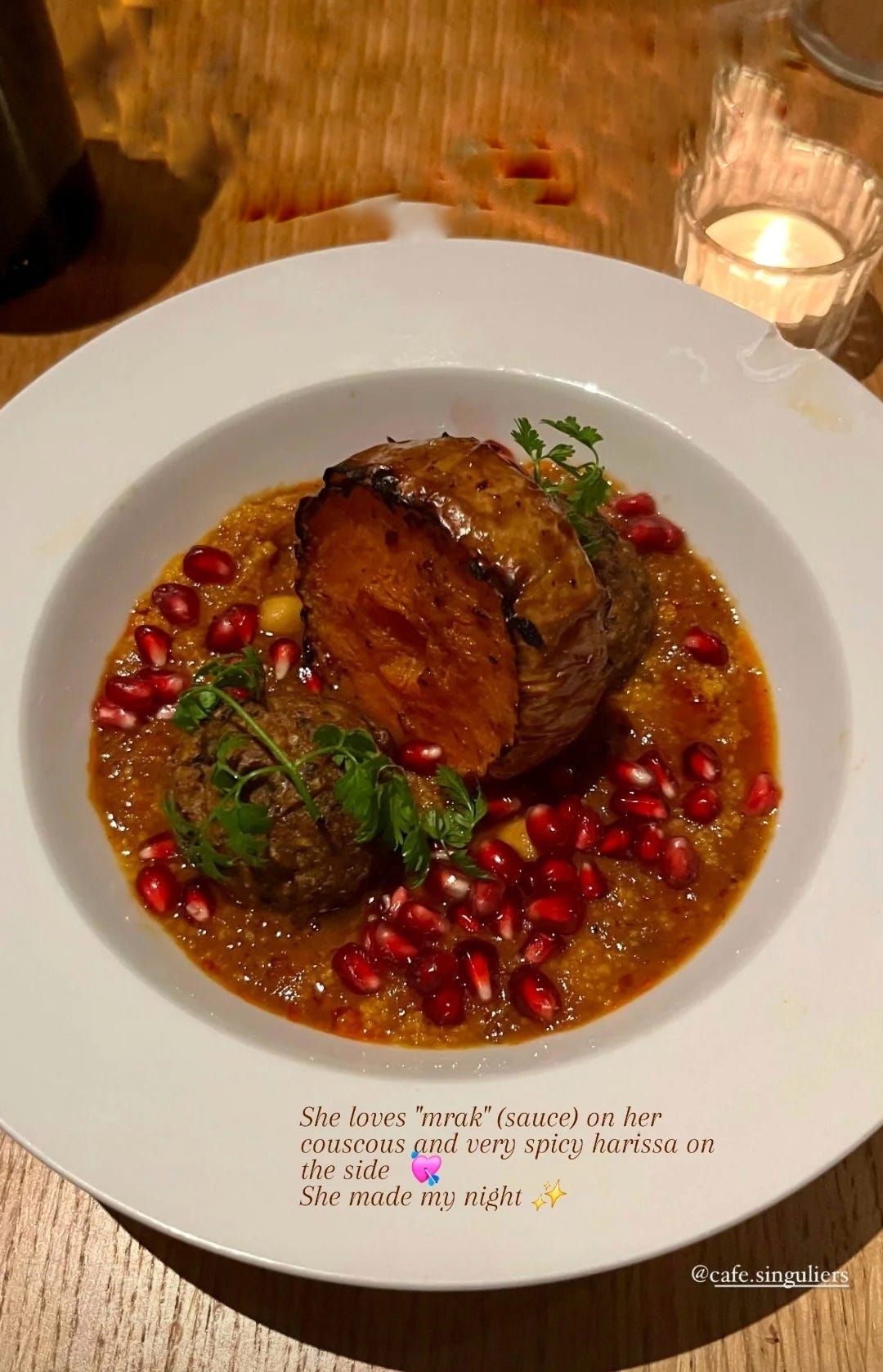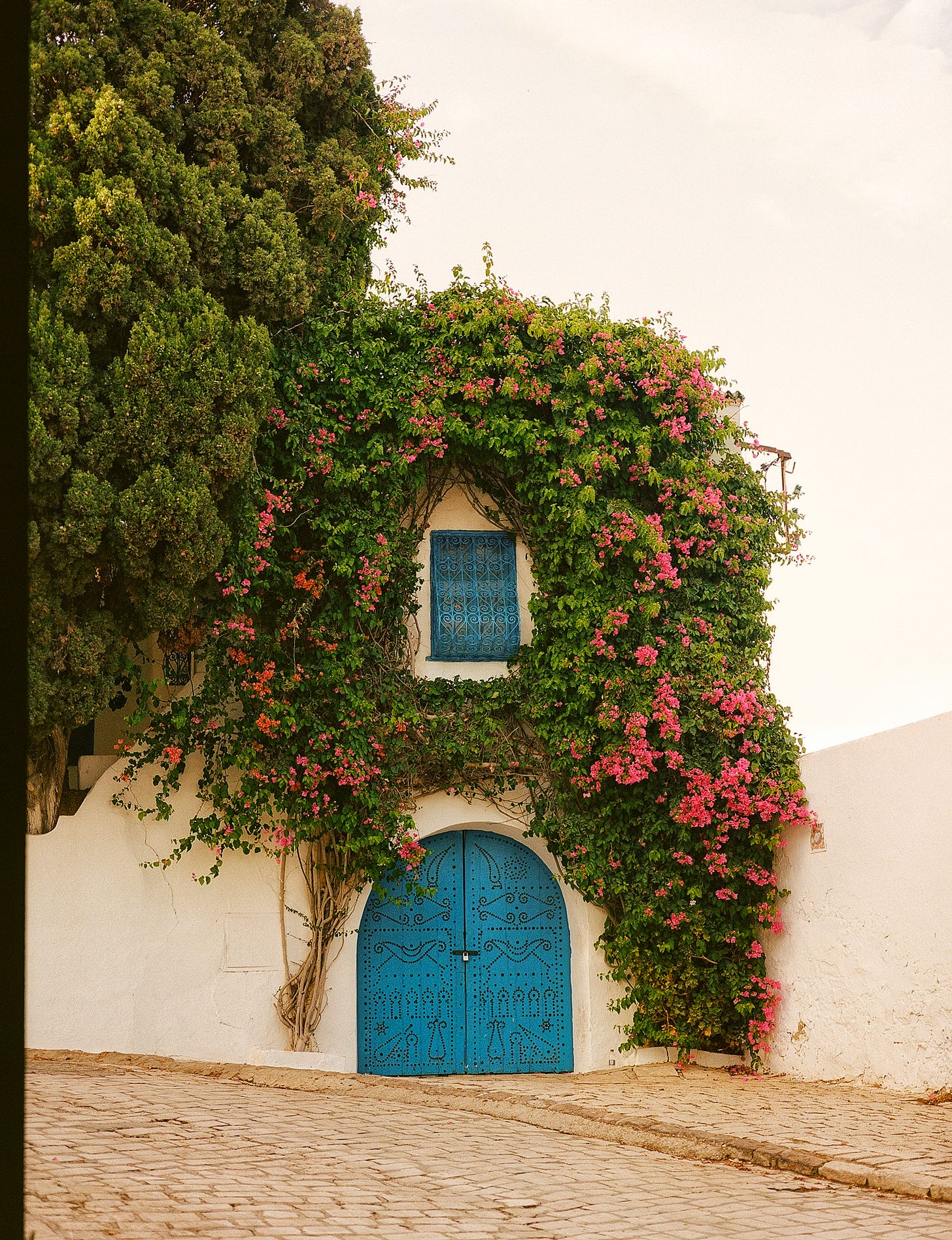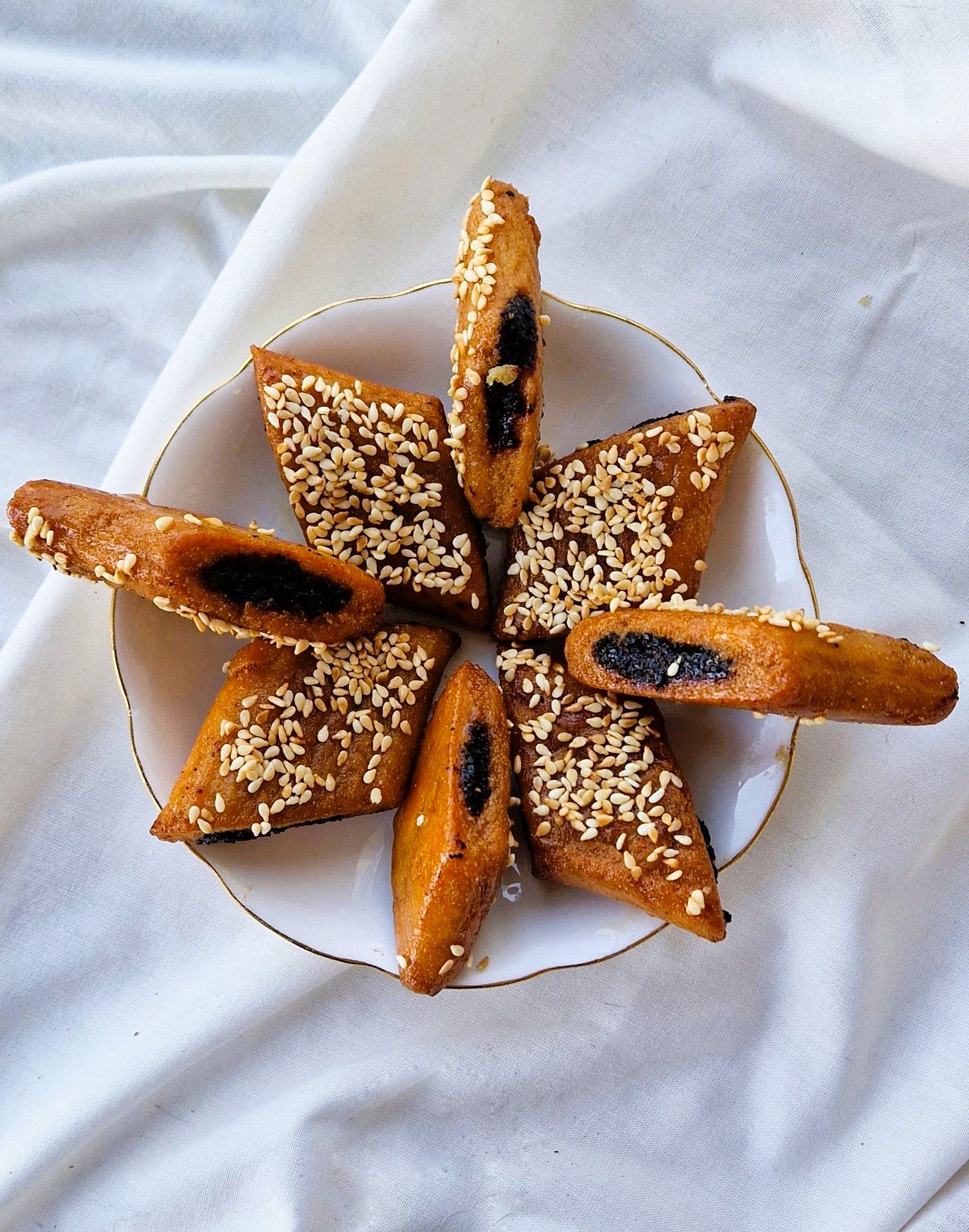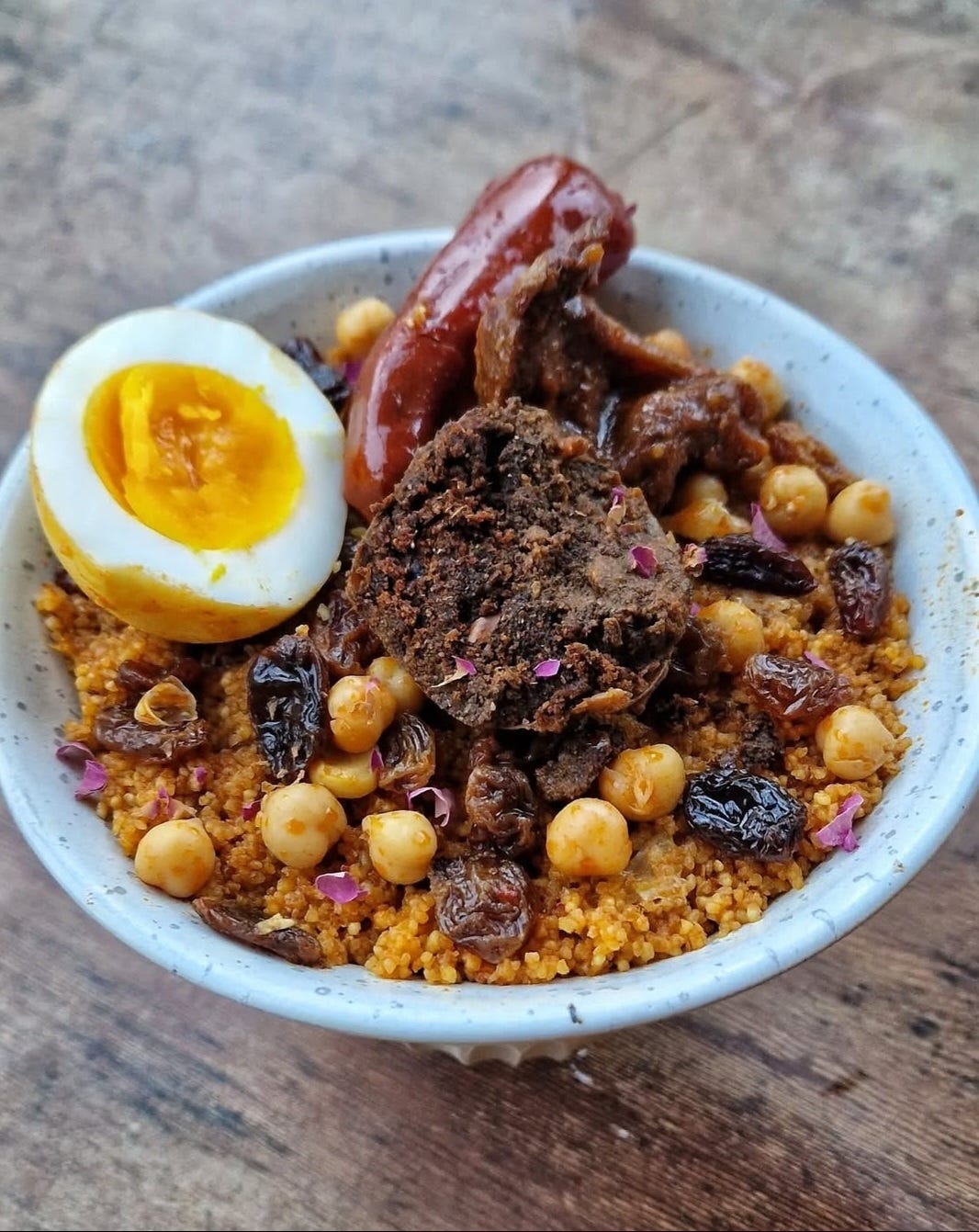Tunisian Cuisine Is the Mediterranean’s Uncredited Star
Why Harissa Is Tunisian—and why Couscous Tells a Bigger Story
Marahba, Hello! I’m Boutheina Ben Salem, a cook, food curator and founder of BabéldeB supper club, based in London. This is the first issue of Kalām, my newsletter. Each month, I’ll deliver Tunisian recipes, cultural dispatches, and curated finds that connect you to the food, art, and heartbeat of Tunisia.
It’s all free, for now.
For some of us, food was the only part of our culture allowed to exist in the open.
Growing up in France meant living under the ever-watchful eye of assimilation. Integration wasn’t just encouraged—it was expected. You were French first, always, and any trace of otherness was meant to stay discreetly tucked behind closed doors.
But there was one glorious exception: food. Maghrebi cuisine was the acceptable ambassador, welcomed into public life with open arms. No complaints on that front, especially when Eïd pastries made their annual appearance—suddenly colleagues and neighbours discovered a newfound love for our culture.
And let’s not forget couscous, crowned France’s favourite dish until 2023. For a fleeting moment, it felt like we had a place at the table, at least through our food.
When I moved to London, I was jolted out of that comfort. Here, Tunisian cuisine was barely understood, casually lumped into the catch-all “North African food.”
Some assumed my cooking must have been “inspired” by more famous Middle Eastern chefs—not that I’m complaining, at least not publicly. Tunisia’s culinary identity was reduced to a hyphen: “Middle Eastern–North African,” as though Tunisia itself were an afterthought rather than a country with a distinctive cuisine.
That said, Tunisian cuisine is beginning to gain recognition in the UK. Jamie Oliver’s documentary series, which featured an episode filmed in Tunisia, spotlighted its vibrant food culture. While some viewers felt his interpretations didn’t quite capture the depth of Tunisian cuisine, it was still progress.
On the other side of the pond, however, Tunisia remains in the shadows of America’s “Mediterranean cuisine” obsession. More than once, I’ve had to explain that yes, Tunisia is Mediterranean—and no, the sea doesn’t stop at Greece, Italy, Spain, and the south of France. I mean, fair enough—branding is a powerful thing. But still, it’s funny how a region that has shaped so much of Mediterranean history barely registers in the conversation. A little geography never hurt anyone… but hey, who am I to challenge culinary expertise built on beetroot hummus?
This neglect isn’t new. In 1998, The New York Times food writer Florence Fabricant noted:
“In America’s rush to adapt and adopt all manner of Mediterranean cooking, one country, Tunisia, has been overlooked.”
But with growing interest from chefs and cultural advocates alike, perhaps it’s time to revisit Fabricant’s words and ensure Tunisia’s culinary narrative is no longer written in the margins.

North Africa Isn’t a Country—And Tunisia Isn’t in the Middle East.
☆☆ Disclaimer: I need to pause here and get something out of the way. This isn’t about appropriation—there’s little I could say that hasn’t already been debated to death.
I don’t personally have a problem with non-Tunisian chefs cooking Tunisian dishes—as long as Tunisian chefs are granted the same platforms to cook, write, and share the food they’ve grown up with. Representation matters. ☆☆
If I’m going to start writing about Tunisia's culinary narrative, there’s only one place to begin: with its national heroine, the iconic harissa.
I’ve heard it called everything from “Middle Eastern spicy sauce” to “North African hot sauce.” For a Cap Bon native (birthplace and world capital of harissa) raised on the stuff, those labels are like swallowing raw chilli seeds—it burns, and not in a good way.
There’s an unmistakable whiff of Orientalism in the way harissa gets labelled—Middle Eastern spicy sauce, exotic North African hot sauce. Slapping on broader, vaguer identities makes it easier to sell, more palatable for mass appeal. But harissa isn’t some faceless heat. It’s rooted in a specific place. As Eric Kim aptly put it, “Real-deal Tunisian harissa is an anchor to the motherland.”
In 2022, UNESCO recognised harissa as part of Tunisia’s cultural heritage—not just a condiment, but a culinary and cultural practice, woven into our daily bread. Harissa is the pulse of Tunisian kitchens.

I make my own harissa, but I've tried a few brands. If you’re looking for the real deal, here are my picks: Baba Bahri (France)—the one I served as kemia during my Paris residency—Lamiri Harissa (UK), and Zwïta (US).
Couscous Is a Ritual, Not Just a Side Dish
Recently, French chef Philippe Etchebest stirred controversy with his vegetarian couscous, which faced criticism for “straying too far from the traditional meaty North African dish”.
I won’t fan the flames of this so-called controversy. Frankly, the backlash is less about authenticity and more about the pragmatics of flavour. For many North Africans, a vegetarian couscous simply lacks the depth and richness traditionally achieved with meat.
What caught my attention, though, was a comment on The Times article describing couscous as “background food.” A throwaway remark, perhaps, but one that perfectly encapsulates a misunderstanding.
In North Africa, couscous is more than just an ingredient—it’s a dish upheld as a vital social practice.

In Tunisia, couscous belongs to the realm of matriarchal cuisine. I have such vivid memories of oula and tkaskiss, the whole ritual of making couscous from scratch. My grandmother used to gather the elder women from the village in my grandparents' houch—a big patio. They all had Amazigh tattoos on their faces. They’d sing old indigenous songs as they sifted flour and shaped the couscous. They were glorious.
Mum, aunties, and their cousins were busy cooking lunch, and we, the kids, had our little jobs—carrying water, bringing clean sheets to lay the couscous out to dry. This act of craftsmanship ties generations together.
The last time we did it the way my grandma used to was at my wedding. Mum wanted to celebrate in the purest tradition. It was also an excuse for a big, joyous gathering—we’ve always loved hosting and cooking. It felt like fifty women and girls came together for the sole purpose of eating, dancing, and laughing. I still remember the voice of my neighbour singing those ancient songs, the sharp tzaghrit (ululations), the smell of incense.
These days, we still do it, but in smaller gatherings. And honestly? It’s enough—to keep me rooted, to keep the tradition alive, to remind me where I come from.
UNESCO recognised couscous as more than just food. Declared an Intangible Cultural Heritage of Humanity, it honours “memories, traditions, and know-how passed down through generations.”
It’s a legacy that stretches beyond borders.
Since 1998, Sicily’s San Vito Lo Capo has hosted the Couscous World Championship as part of its annual Cous Cous Fest. This past summer, I took part in Marseille’s annual Kouss-Kouss Festival that transforms the city into a stage for culinary and cultural exchange, where chefs gather to honour couscous in all its forms.
This Berber dish, carried across the Mediterranean during the Berber-Arab conquests (though no conquest deserves glory), now unites chefs worldwide in a celebration of its enduring cultural legacy.
Calling couscous background food? That’s like calling a symphony background noise. Unthinkable.

“Couscous. A shared dish synonymous with communion and togetherness in multiple forms: personal bonding; communal diversity (because couscous varies from region to region); collective participation.” I CAME FOR COUSCOUS manifesto
Couscous Royal? That’s Not How We Eat It

There’s no single way to make couscous. Every region has its own take, and across the Maghreb, it varies even more.
Tunisian couscous is anything but one-note. Across the country, it shifts in flavour and tradition, each variation a testament to regional identity.
On Kerkennah Island, the sea takes centre stage— they make a mean octopus couscous and stuffed calamari couscous. In Kef, north-west Tunisia, spring arrives with couscous borzgen, a sweet-savoury masterpiece of tender lamb, rosemary, toasted nuts, and warming cinnamon. Eid el-Adha calls for couscous uzban—stuffed spiced offal, parsley, and onions—a dish of devotion. My personal favourite is couscous kadid and uzban chayah, where cured meats and offal meet deep, layered spices. And then there’s farfoucha, a minimalist’s dream—vegetarian, bright with fennel fronds.
And let’s clear one thing up: couscous royal? That’s a French invention dear readers. You won’t find it in our home kitchens in Maghreb. We cook with one meat at a time—lamb or mutton, beef, or chicken. Never all three, never a mix.
Have you ever had a couscous that surprised you?
If you’ve made it this far, thank you—you’re my kind of people.
This week, subscribers will get a baghrir recipe—the fluffy Berber pancake—in celebration of Shrove Tuesday, landing in your inbox on Friday. And later today, I’ll be sharing the first portrait in a series celebrating strong, creative Tunisian women and their craft.
B x







I felt a sense of satisfaction while reading your newsletter, especially your highlighting of "the massacre of the couscous" and your discussion of the so-called "couscous royal" as a French-made diversion from North African culture. I look forward to reading more; please continue to amaze us.
Mabrouk mabrouk- just finished reading it! Thoughtful and engaging writing- gave me a lot to think about. Looking forward to reading more from you!